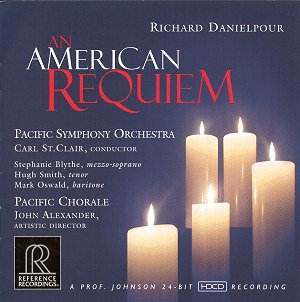During his preliminary work on what was to become An
American Requiem, Danielpour interviewed American war veterans
who fought either in World War II, the Korean War or the Vietnam War.
One of the aspects unanimously emphasised by the interviewees was that
war, whatever its political and social agendas, is ultimately about
human suffering, private or collective. So, in devising the text sequence,
Danielpour and his librettist Kim Vaeth chose to contrast the Latin
words from the traditional Requiem Mass with English words by Whitman,
Emerson, Michael Harper, Hilda Doolittle (poems written in 1944 during
the bombing of London) and an anonymous spiritual. This is not an uncommon
practice nowadays, and the global impact is quite comparable to that
of Brittenís War Requiem. Indeed, Danielpourís An
American Requiem bears some passing semblance to Brittenís work,
though the composer manages to remain his own man throughout.
The work comprises two main parts of fairly equal length,
each falling into shorter sections. The opening Requiem Aeternam
opens calmly with tolling chords on the piano supporting the quietly
chanting voices. In Vigil I, the mezzo-soprano sings Whitmanís
Sea-winds from east and west (from Memories of President Lincoln)
and Emersonís Was there no star (in which the poet deplores the
death of his son). The chorus takes over with the Kyrie. The
martial and war-like Dies Irae section (shades of Stravinsky
here) frames the tenorís singing of A Dirge for two Veterans
(Whitman again). Vigil II in which the baritone has another Whitman
setting (Vigil strange I kept) is followed by the Lacrimosa
and the Pie Jesu, the last section of Part I, in which all forces
join. Part II opens with the Sanctus-Benedictus. Again, faint
echoes of Britten here: the Sanctus is introduced with bell sounds
and some solo singing of the tenor. The chorus then freely chants in
Pleni sunt coeli building-up some considerable tension towards
the mighty outburst of the Hosanna. The ensuing Benedictus
is sung by soloists with solo cello and mildly dissonant piano chords
and is then repeated by the chorus supported by the orchestra. This
leads to a restatement of the majestic Hosanna. There follow
two short sections in which the mezzo-soprano sings a poem by Michael
Harper and the baritone a spiritual. As far as I am concerned, these
sections, cast in a somewhat jazzy manner, are a slight miscalculation
(and the only one) on the composerís part, in that they tend to disrupt
the prevailing atmosphere of the whole work. The chorusís peaceful singing
of the Agnus Dei frames a beautiful setting for mezzo and tenor
of another text by Michael Harper. The following Libera Me (chorus
and baritone) leads into another pair of songs (tenor and mezzo) on
words by Hilda Doolittle. The final section Lux Aeterna, at first
unaccompanied, in an appeased mood, ends with a restatement of the Requiem
Aeternam thus bringing the piece full circle.
Again, Brittenís War Requiem may have
been an inspiring model, but Danielpourís An American Requiem
is a substantial, deeply-felt and honest piece of music in which the
composerís gifts for dramatic expression often achieved in a simple
but telling way are quite evident, as is his fluent writing for voices
that always lies comfortably in the voicesí most expressive register.
The orchestral writing is expertly done, as it usually is in this composerís
highly communicative music. This powerfully expressive work receives
a superbly committed reading from all concerned (soloists and chorus
sing beautifully and the somewhat enlarged Pacific Symphony orchestra
play with a fine sense of ensemble) and is warmly recorded in natural
acoustics.
A deeply-felt, well-crafted and often moving piece
that undoubtedly deserves wider recognition and that is well worth more
than the occasional hearing.
Hubert Culot


